Suspended Animation #406
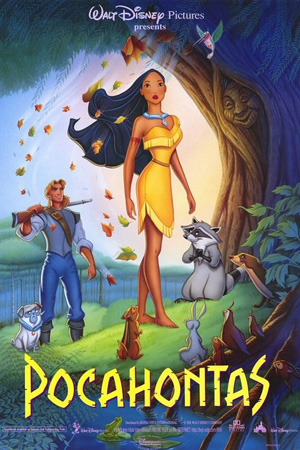 The Disney animated feature film Pocahontas (1995) was a romanticized fantasy inspired by the folklore and legend of Pocahontas rather than her actual life. Being a hybrid of a real person and a Disney creation caused issues for audiences and to this day, the film has never been considered for a live action remake, Broadway musical, Disney Channel animated series or any other possible uses.
The Disney animated feature film Pocahontas (1995) was a romanticized fantasy inspired by the folklore and legend of Pocahontas rather than her actual life. Being a hybrid of a real person and a Disney creation caused issues for audiences and to this day, the film has never been considered for a live action remake, Broadway musical, Disney Channel animated series or any other possible uses.
Disney had to use some artistic license from the real story where Pocahontas was roughly eleven years old when she supposedly saved the twenty-eight year old John Smith’s life.
In addition, it could not be a story where the couple fell in love and lived happily ever after together, since Smith abandoned her in America and she later married British colonist John Rolfe.
So Disney created an awkward, illogical ending where Smith’s wounds are so severe that Pocahontas’ tribe’s proven effective natural holistic remedies have to be ignored so that he can spend many months at sea bleeding on a bacteria-ridden, rat-infested ship.
It would have made more sense to stress that Smith had to return to England to testify, since his status and reputation would make him a credible witness, so that the crew wouldn’t get hung for mutiny against Ratcliffe.
However, Pocahontas was indeed the daughter of Chief Powhatan who ruled an alliance of Algonquin Native America tribes in Virginia and she had been married to a warrior named Kocoum who was killed by the colonists.
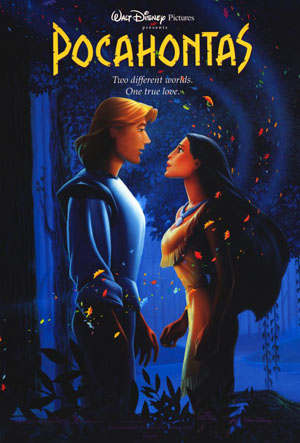 By the way, the real Pocahontas was not a princess, because her tribe never had that designation like some of the Western Plains tribes. At best, her status might be comparable to being the daughter of the President of the United States, which wouldn’t make her a princess but gave her special privileges.
By the way, the real Pocahontas was not a princess, because her tribe never had that designation like some of the Western Plains tribes. At best, her status might be comparable to being the daughter of the President of the United States, which wouldn’t make her a princess but gave her special privileges.
However, she was often treated as a princess. Cleric and travel writer Samuel Purchas recalled meeting Pocahontas in London, noting that she impressed those whom she met because she “carried her selfe (sic) as the daughter of a king”. When he met her again in London, Smith referred to her deferentially as a “King’s daughter”. Of course, Disney has included her in the lucrative Disney Princess Franchise in an effort at diversity.
Shirley “Little Dove” Custalow McGowan is a descendant of Virginia’s Powhattan Indians. James Pentacost, the producer of Disney’s Pocahontas (1995), first saw her in June 1992 while visiting the Native American Festival at Jamestown with a couple of Disney writers.
McGowan worked occasionally at the Jamestown Festival Park and traveled all over Virginia and along the East Coast, presenting programs on the history and culture of her Algonquin ancestors who included Pocahontas.
“We didn’t meet her then,” stated Pentacost to the Daily Press in 1993. “But when we came back in October I brought a larger group – about eight or nine artists and writers. We met her then and talked. Glen Keane photographed and videotaped her.”
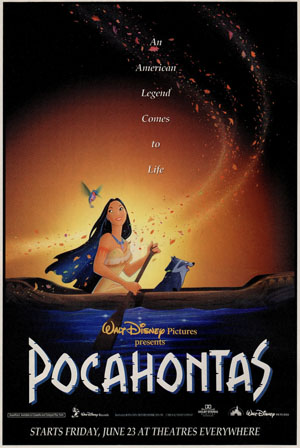 McGowan consulted with the Disney Studios three times about the film, but eventually felt that the production was not adhering strictly enough to historical accuracy and disavowed any further participation. She asked for her name to be removed from the film but it was not.
McGowan consulted with the Disney Studios three times about the film, but eventually felt that the production was not adhering strictly enough to historical accuracy and disavowed any further participation. She asked for her name to be removed from the film but it was not.
Originally, Pocahontas’ animal friend was to have been a comedic talking turkey named Redfeather, who thought he was quite a ladies’ man, and who would be voiced by comedian John Candy. With Candy’s death in 1994, and further development on the script, it was determined that no animals should talk.
Storyman Joe Grant said, “I always saw Pocahontas as a child of nature. Pocahontas is one with nature as are the animals, steams, trees, leaves. It was impossible for me not to think of her as part of that world. Her relationship with the animals is also part of a Disney tradition to deriving humor and comedic support from animals.”
Producer Jeffrey Katzenberg told Pocahontas’ supervising animator Glen Keane to make Pocahontas “the most idealized and finest woman ever made”.
Keane remembered, “Anytime you’re developing a character, you try to go someplace to find inspiration. For Pocahontas, we went to Virginia. As I was walking through the woods I was imagining that this is where John Smith and Pocahontas would meet, maybe over there on that little hill. Maybe they saw the very same river that I’m looking at right now.
“As I was thinking of all this, I heard a voice calling: ‘“Scuse me, ‘scuse me, are you Glen Keane?’ Then this Indian girl comes running up and says, ‘you’re the animator who’s doing Pocahontas, aren’t you? My name is Shirley Littledove.’
“There was another girl next to her, and Shirley said, ‘This is my sister, Debbie Whitedove. We are descendants of Pocahontas. Our father is the chief of the Powhatan tribe of Indians.’
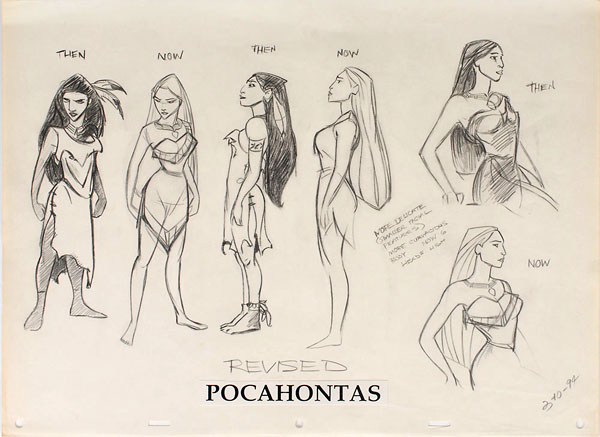
“The way Shirley stood there, all I can say is there was a spiritual presence with her. There was a dignity about her. She spoke very calmly with long, pregnant pauses between everything she said, and she just looked through me. I started stumbling on my words. I didn’t know how to refer to Native Americans. Then I felt, maybe this was how John Smith felt when he met Pocahontas!
“And as they stood there, I mean … I took a picture of both of them, and between their faces was Pocahontas’ face in my mind – I could see her. They were both beautiful; they had nobility in the way they stood. All the way through the film, I had that photo on my desk there as a reminder of that.”
Other inspirations for the character were Natalie Belcon, Naomi Campbell, Jamie Pillow, Kate Moss, Charmaine Craig, Christy Turlington, Dyna Taylor and voice actress Irene Bedard who felt that in the final design, “they captured certain facial expressions and the way my hands moved. One of my habits is pushing my hair behind my ear and I noticed that Pocahontas has the same habit.”
For almost three years, Taylor who was a 21 year old senior at California Institute of the Arts and of Filipino heritage sat for four three-hour modeling sessions being paid a total of $200 in which she was videotaped so the animators could draw poses of her from different angles.
Glen Keane apparently gave her a signed picture of Pocahontas that says, “To Dyna, with gratitude for the inspiration you gave us.”
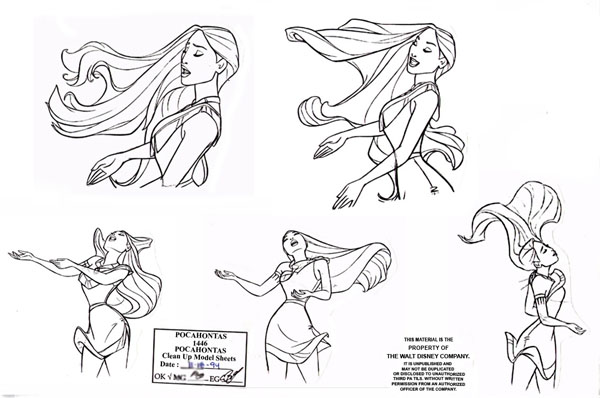
Keane also looked to a 1620 depiction of Pocahontas from a history book. In an attempt to make the character look distinct, some vaguely Asian elements were incorporated to the face, especially in the shape of the eyes. In fact, when Disney introduced a walk around character to its parks, very few of the performers were Native American. Many were from the Pacific Rim and Asian areas.
The clean up artist on the character Renee Holt-Bird stated, “Pocahontas’ hair free-flowing, random, streamlined aspect struck me as very reminiscent of Art Deco architecture. It is a character in itself. It’s really an expression of her freedom, her soulful quality. It was wonderful to work with and it reminded me of how mesmerized I was as a child by the elegant, sensuous flicking tail of the goldfish in Pinocchio.”
”We’re doing a mature love story here, and we’ve got to draw her as such. She has to be sexy,” said Keane, who likened Pocahontas to a tribal Eve. ”This is a Disney version. This is not a documentary.”


 Jim Korkis is an internationally respected animation historian who in recent years has devoted his attention to the many worlds of Disney. He was a columnist for a variety of animation magazines. With his former writing partner, John Cawley, he authored several animation related books including The Encyclopedia of Cartoon Superstars, How to Create Animation, Cartoon Confidential and Get Animated’s Animation Art Buyer’s Guide. He taught animation classes at the Disney Institute in Florida as well as instructing classes on acting and animation history for Disney Feature Animation: Florida.
Jim Korkis is an internationally respected animation historian who in recent years has devoted his attention to the many worlds of Disney. He was a columnist for a variety of animation magazines. With his former writing partner, John Cawley, he authored several animation related books including The Encyclopedia of Cartoon Superstars, How to Create Animation, Cartoon Confidential and Get Animated’s Animation Art Buyer’s Guide. He taught animation classes at the Disney Institute in Florida as well as instructing classes on acting and animation history for Disney Feature Animation: Florida.




















































One day in the mid-’90s I was visiting a friend when I heard some very dramatic orchestral music coming from the house next door. I couldn’t identify the piece, and when I mentioned it my friend said it was the “Pocahontas” soundtrack album, which the little neighbour girl played compulsively over and over again. I hadn’t yet seen the film, but the music was clearly of a very high calibre, and I was heartened that it had made such a deep impression on a child.
As it happened, my friend would later write a couple of books about Native American earthworks. He’s one of these white Americans one occasionally meets who believes that Native Americans can do no wrong and are essentially without fault: for example, that native oral tradition is a 100% accurate representation of the historic record, whereas Western scientific archaeology is incapable of discovering anything of value. So it’s ironic that Native American leaders have denounced his books and their conclusions.
I’m reminded of this by Jeffrey Katzenberg’s admonition to make Pocahontas not just a strong and compelling character, but “the most idealized and finest woman ever made.” But idealising Native Americans does exactly what the worst xenophobes have done: it denies them their humanity. The objections to “Pocahontas” focus largely on those elements of the film that simply aren’t REAL. Of course, Disney’s takes on Johnny Appleseed and Ben Franklin aren’t historically accurate either, but they’re not set against a background of dispossession and genocide.
There’s a lot of good in “Pocahontas”, even greatness. I think its biggest problem was the company’s self-conscious desire to please everybody and to offend nobody. That never works.
So Dyna Taylor was paid a total of only $200 for four three-hour modelling sessions? I realise that few models make the really big money, but this works out to less than $20 an hour, a niggardly sum. After all, Sherri Stoner got $500 a session for her live-action reference work on “The Little Mermaid”, and I’m sure she was worth every penny.
Actually, there were plans for an animated series. Glenn even did some designs for it. However, it was never developed.
Also, didn’t we just talked about Pocahontas here a few months ago?
Jim’s earlier column about “Pocahontas” was posted here in July 2019, three and a half years ago. Time flies!
Though the film Pocahontas cannot be taken literally as history, there are an amazing number of historical details that did make it into the film. So in analyzing the film for a class, it can be a catalyst for discussion about the time period and setting. What was accurately done and what was changed and why can create some lively topics. Interestingly, the basic legend about Pocahontas and Captain John Smith remains intact.
Mention should also be made of Pocahontas II; Journey to a New World which was a direct-to-video release including several of the original cast members. Unlike most sequels to classic Disney films, this one is not a rehash of the same elements from the original but rather brings the character of Pocahontas into an entirely fresh (for her) setting and introduces an important new character in the person of John Rolfe, whom of course she later married. The two films work in tandem. More like a Part One and Part Two of Pocahontas’ story. The sequel puts the first film in a different perspective than if the first one is viewed as a stand-alone.
As was mentioned in the above article, Pocahontas was incorporated into the Disney Princess lineup and as such she contributes a unique version of “Silver and Gold” to the Disney Princess Christmas Album.”
I would also like to mention the song “Colors of the Wind,” which beautifully expresses the philosophies and point of view of the film character. “Just Around the River Bend” is another tour-de-force, containing many applications depending on the listener.
I did not warm up to this movie at first. I could still do without the cutesy animal sidekicks. But over the years I have come to appreciate the effort that went into it, the artistry, and the attempt by the Disney artists to explore new horizons. (Note that I said “attempt”; I realize they did not entirely succeed at taking their art form in new directions, but it cannot be denied that a great deal of work and historical research went into this film. That alone makes it worthy of study.)
Next you’ll be telling us that “Ben and Me” isn’t historically accurate, either; that a mouse didn’t really give Benjamin Franklin all his ideas.
It was based on a book………….
It wouldn’t surprise me if some tried to claim it was closer to being historically accurate…
In a better world, this movie would get the Song of the South treatment
Yeah, I disagree there. It’s not that problematic.